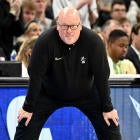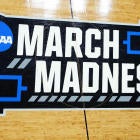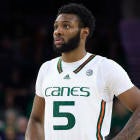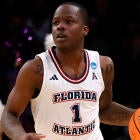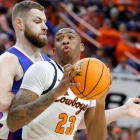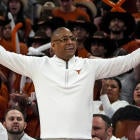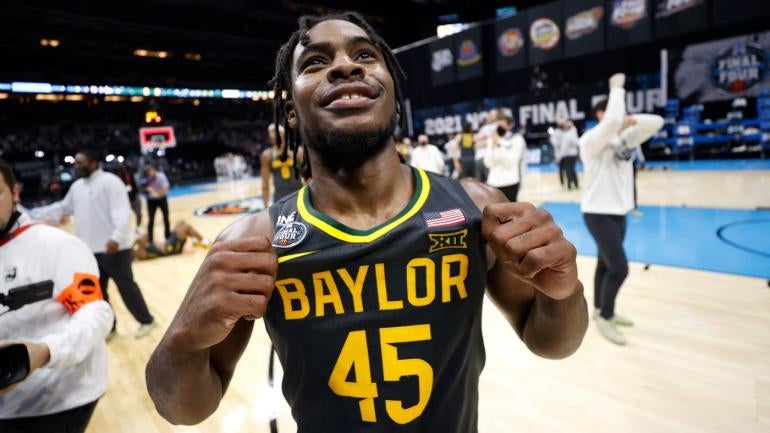
Thanks to the addition of advanced metrics, college basketball fans and analysts have a better picture of what a national championship team looks like. From the offense, to the defense and even some more minor statistical landmarks, it isn't difficult to build a window into which all recent title teams have fallen.
And yet one of the best indicators, from long before basketball's statistical revolution, still holds true. Deploying pure, raw, unfiltered, NBA talent.
Of the 45 men's college basketball national champions since 1976, the year of the NBA/ABA merger, 44 featured at least one first-round pick in a future NBA Draft.
Even that number is slightly deceptive: 1987 Indiana stands as the outlier, with Steve Alford standing as the team's highest draft pick, going to the Dallas Mavericks in the second round. But Alford was the 26th player taken, which would mark him as a first-round pick today. In 1987, each round had just 23 selections, with the NBA moving to 30 picks when the Charlotte Bobcats joined the league in 2004.
So slightly rephrased, 45 of 45 title-winners have produced at least one top 30 pick (which equates to a current day first-round pick).
Of those 45 national champions since the merger:
- 37 suited up multiple first-round selections.
- 36 produced a first-round pick in the NBA Draft immediately following their national championship (i.e. 2021 Baylor in the 2021 NBA Draft)
- 36 fielded a future top 10 NBA Draft pick. That includes a 27-of-30 run from 1976-2005.
- 24 featured at least one top five selection.
- Eight starred No. 1 overall picks. This hasn't been as prevalent of late; from 1976-1991, national championship teams yielded seven top picks. There's been just one since, Kentucky's Anthony Davis in 2012.
That all but one champion produced at least one first-round pick comes as somewhat of a surprise. While more talent is better than less, it seems like there would be some team, at some point over the last 45 years that would have triumphed as a collection of really good college players who exceeded their potential as a made-for-TV team better than the sum of its parts. Along those same lines, it's more surprising that a team full of decent NBA prospects didn't get the job done, say a collection of second-round picks. Remember: three of the last five winners of the Naismith Player of the Year Award (Frank Mason III, Jalen Brunson and Luka Garza) have been second-round picks.
There's a chicken-and-the-egg argument to be had here. Particularly in the early years after the merger, drafting was a more inexact science. And it's worth asking: Were teams winning because they had more NBA talent, or were NBA teams at some level drawn to some of those players because they were winning?
With such a large sample size, reference points for both exist. Yes, Georgetown put itself into position to play for multiple titles and win the 1984 championship because it had a legitimate No. 1 pick in Patrick Ewing dominating the paint. UNLV likely raced to the 1990 title because Jerry Tarkanian suited up three top 12 picks; Duke detonated the Runnin' Rebels' undefeated season a year later with three future top seven picks.
And yes, there are also players who imprinted on NBA radars because they were attached to teams that won, with those players often thriving on the biggest possible college stage. Some of those players went on to prove those March Madness evaluations correct; others not so much.
That's true of nearly any draft strategy played out over such a long time period. Some can't-miss prospects fulfilled their promise. Others seemingly checked every box and still fell flat. Still others were overlooked but found their NBA runway and exceeded all expectations.
And while the tools for evaluating potential NBA players have evolved — try explaining box plus-minus to teams drafting in the late 1970s — one thing rings almost universally true: it takes a first-round pick to win a national championship.
First-rounders on NCAA Tournament champs
First-round NBA Draft picks from each season's NCAA Tournament champion since the NBA/ABA merger in 1976 with each player and what pick they were in the draft.
| Year | NCAA Champion | First Round NBA Draft Picks |
|---|---|---|
| 1976 | Indiana | Scott May 2, Quinn Buckner 7, Bob Wilkerson 11 (1976); Kent Benson 1 (1977) |
| 1977 | Marquette | Bo Ellis 17 (1977); Butch Lee 10 (1978) |
| 1978 | Kentucky | Rick Robey 3, Jack Givens 16 (1978); Kyle Macy 22 (1979) |
| 1979 | Michigan State | Magic Johnson 1, Greg Kelser 4 (1979) |
| 1980 | Louisville | Darrell Griffith 2 (1980); Rodney McCray 3 (1983) |
| 1981 | Indiana | Isiah Thomas 2, Ray Tolbert 17 (1981); Randy Wittman 22 (1983) |
| 1982 | North Carolina | James Worthy 1 (1982); Michael Jordan 3, Sam Perkins 4 (1984) |
| 1983 | N.C. State | Thurl Bailey 7 (1983) |
| 1984 | Georgetown | Patrick Ewing 1 (1985); Reggie Williams 4 (1987) |
| 1985 | Villanova | Ed Pinckney 10 (1985); Harold Pressley 17 (1986) |
| 1986 | Louisville | Billy Thompson 19 (1986); Pervis Ellison 1, Kenny Payne 19 (1989) |
| 1987 | Indiana | None |
| 1988 | Kansas | Danny Manning 1 (1988) |
| 1989 | Michigan | Glen Rice 4 (1989); Rumeal Robinson 10, Loy Vaught 13, Terry Mills 16 (1990) |
| 1990 | UNLV | Larry Johnson 1, Stacey Augmon 9, Greg Anthony 12 (1991) |
| 1991 | Duke | Christian Laettner 3 (1992); Bobby Hurley 7 (1993); Grant Hill 3 (1994) |
| 1992 | Duke | Christian Laettner 3 (1992); Bobby Hurley 7 (1993); Grant Hill 3 (1994); Cherokee Parks 12 (1995) |
| 1993 | North Carolina | George Lynch 12 (1993); Eric Montross 9 (1994) |
| 1994 | Arkansas | Corliss Williamson 13 (1995) |
| 1995 | UCLA | Ed O'Bannon 9, George Zidek 22 (1995) |
| 1996 | Kentucky | Antoine Walker 6, Tony Delk 16, Walter McCarty 19 (1996); Ron Mercer 6, Derek Anderson 13 (1997); Nazr Mohammed 29 (1998) |
| 1997 | Arizona | Mike Bibby 2, Michael Dickerson 14 (1998); Jason Terry 10 (1999) |
| 1998 | Kentucky | Nazr Mohammed 29 (1998); Scott Padgett 28 (1999); Jamaal Magloire 19 (2000) |
| 1999 | UConn | Richard Hamilton 7 (1999) |
| 2000 | Michigan State | Mateen Cleaves 14, Morris Peterson 21 (2000); Jason Richardson 5 (2001) |
| 2001 | Duke | Shane Battier 6 (2001); Jay Williams 2, Mike Dunleavy Jr. 3 (2002) |
| 2002 | Maryland | Chris Wilcox 8, Juan Dixon 17 (2002) |
| 2003 | Syracuse | Carmelo Anthony 3 (2003); Hakim Warrick 19 (2005) |
| 2004 | UConn | Emeka Okafor 2, Ben Gordon 3 (2004); Charlie Villanueva 7 (2005); Hilton Armstrong 12, Marcus Williams 22, Josh Boone 23 (2006) |
| 2005 | North Carolina | Marvin Williams 2, Raymond Felton 5, Sean May 13, Rashad McCants 14 (2005) |
| 2006 | Florida | Al Horford 3, Corey Brewer 7, Joakim Noah 9 (2007) |
| 2007 | Florida | Al Horford 3, Corey Brewer 7, Joakim Noah 9 (2007); Marreese Speights 16 (2008) |
| 2008 | Kansas | Brandon Rush 13, Darrell Arthur 27 (2008); Cole Aldrich 11 (2010) |
| 2009 | North Carolina | Tyler Hansbrough 13, Ty Lawson 18, Wayne Ellington 18 (2009); Ed Davis 13 (2010); Tyler Zeller 17 (2012) |
| 2010 | Duke | Nolan Smith 21 (2011); Miles Plumlee 26 (2012); Mason Plumlee 22 (2013) |
| 2011 | UConn | Kemba Walker 9 (2011); Jeremy Lamb 12 (2012) |
| 2012 | Kentucky | Anthony Davis 1, Michael Kidd-Gilchrist 2, Terrence Jones 18, Marquis Teague 29 (2012) |
| 2013 | Louisville | Gorgui Dieng 21 (2013) |
| 2014 | UConn | Shabazz Napier 24 (2014) |
| 2015 | Duke | Jahlil Okafor 3, Justise Winslow 10, Tyus Jones 24 (2015); Grayson Allen 21 (2018) |
| 2016 | Villanova | Josh Hart 30 (2017); Mikal Bridges 10, Donte DiVincenzo 17 (2018) |
| 2017 | North Carolina | Justin Jackson 15, Tony Bradley 28 (2017) |
| 2018 | Villanova | Mikal Bridges 10, Donte DiVincenzo 17, Omari Spellman 30 (2018) |
| 2019 | Virginia | De'Andre Hunter 4, Ty Jerome 24 (2019) |
| 2021 | Baylor | Davion Mitchell 9 (2021) |
Editor's Note: Only players that played on each team were listed. So for instance, Kansas' Mark Randall, who was on the 1987-88 championship team, but redshirted, or Kentucky's Scott Padgett, who was on roster but ineligible in 1995-96, did not count for those respective teams. Padgett did play for the Wildcats' 1997-98 title-winner, and counted for that team.













